 Effective leaders recognize that business strategy, culture and brand strategy are inseparable. The ability to link these three core components together from the top-down is critical to creating and maintaining a successful healthcare brand.
Effective leaders recognize that business strategy, culture and brand strategy are inseparable. The ability to link these three core components together from the top-down is critical to creating and maintaining a successful healthcare brand.
Strong brands demonstrate true alignment of the company’s rational and logical business strategy with its emotional and human culture. In other words, strategy and culture combine to drive business results and define brands. While a solid business strategy guides your company’s direction and activities, culture conveys your company’s spirit and character. The brand strategy brings everything together by aligning actions with communications to win the hearts and minds of your customers.
Cultural Alignment is Key
Your company’s culture—its values, practices, attitudes and behaviors—is a powerful strategic asset and a sustainable point of difference. According to Corporate Culture: Evidence from the Field (a joint study from Duke and Columbia), an effective culture fosters creativity and encourages productivity, resulting in improved firm value and profitability. It promotes more risk tolerance, mitigates myopic behavior, and creates an open climate for ideas to germinate organically.
While strategy can be emulated, culture cannot. Culture is unique to every organization. It is your company’s character inspired through its leaders, demonstrated through its core values, and displayed in every customer interaction.
As a Vistage member, I had the pleasure of hearing Edgar Papke discuss the merits of aligning culture, strategy and brand. In his book, True Alignment: Linking Company Culture with Customer Needs for Extraordinary Results, Papke emphasizes the importance of cultural alignment in making emotional connections with customers. From luxury automakers to big-box discount stores, successful brands across the spectrum have skillfully aligned strategy and culture.
Papke suggests companies demonstrate the characteristics of one of three types of cultures. Each culture aligns with a specific strategic intention – or as we like to call it, brand platform. This alignment is the way firms win in the market.

Let’s take a closer look at Papke’s three culture types using real-life examples:
Participation cultures emphasize collaboration and teamwork, along with shared responsibility, rewards and decision-making. Within participation cultures:
- Community brands bring like-minded people together for a shared purpose and experience. These include Disney, YouTube and Starbucks.
- Disney – “The happiest place on earth” – lists Community among its core values. All employees in this Participation culture are united around a common goal: to help the guest. Walt Disney recognized the importance of company culture, creating the model that remains the standard to this day: hire for attitude, not aptitude. All employees participate in a universal culture, ensuring customers feel welcome and a part of the Disney experience.
- Customization brands, such as Lids and Lands’ End, include customers in the brand experience.
- Lands’ End exemplifies the Customization brand platform and Participation culture. The company excels in both the business-to-consumer and the business-to-business segments. While Lands’ End offers items customized to individual consumers’ measurements and tastes, it also is a major purveyor of customized corporate wear, providing high-quality promotional products to businesses, as well as dress-code-appropriate school uniforms and clothing. Driven by its alignment with and success in customization, the company aspires to reach $5 billion in revenue in 2020. Lands’ End stands behind everything it sells with its unlimited guarantee, ensuring customer needs always come first by empowering employees to find new ways to deliver products in alignment with its brand platform.
Expertise cultures emphasize individual competencies, skills, and pay-for-performance, and they are often characterized by top-down decision-making. Within expertise cultures:
- Preeminence brands stand out as innovators in their industries. Apple, Tiffany’s and Bose are among them.
- Apple is a standout in the Preeminence category. Apple employees at all levels are united by a common Expertise-driven culture, driven by the company’s core values: to make the best products in the market and focus on innovating select products that either create new product categories or have high potential to lead in their categories. This is exhibited in Apple’s consistently high-quality products, and it is the reason customers can expect the same experience at any Apple store.
- We also believe another Preeminence brand is Mayo Clinic, which has stood the test of time for more than 150 years, growing from a family medical clinic to a world-renowned medical institution. Attributed to its “enduring culture of patient-centeredness and medical teamwork,” Mayo Clinic is preferred by patients to treat serious illness nearly 3:1 over the second-leading academic medical center. Its patient-first focus is evident not only in attracting patients, but also in attracting some of the world’s most highly esteemed specialists.
- Low-Price brands seek to save customers money. Examples include Walmart, IKEA and Aldi.
- Walmart, a Low-Price brand with an Expertise culture, operates with a common purpose of driving efficiency and managing workflow to save people money so they can live better. With a commitment to “transforming the future of commerce,” Walmart has become the largest retailer in the world, serving more than 260 million customers every week.
Authenticity cultures emphasize company values, causes, group-based participation and decision-making, and “doing the right thing.” Within authenticity cultures:
- Physical Wellbeing brands convey health and wellness, and include brands such as Curves, Evian and Kaiser Permanente’s Thrive.
- Personal Actualization brands strive to make customers’ lives better through socially or environmentally conscious acts. TOMS, Ben & Jerry’s, and Whole Foods are examples.
- Ben & Jerry’s, a Personal Actualization brand, provides an example of highly effective culture and brand management during corporate transition. Driven by social responsibility and social activism, Ben & Jerry’s founders promoted an Authenticity culture by using eco-friendly packaging along with sustainable, organic and certified Fair Trade suppliers, purchasing premium hormone-free dairy products from regional farmers, and creating work for disadvantaged people. When the company was bought by business conglomerate Unilever in 2001, the new CEO demonstrated cultural awareness and agility to help maintain the core values and culture of the company by adapting to its management style and norms. Ben & Jerry’s culture and values remain largely intact today as it continues its philanthropic work and publicly reinforces its commitment to “doing good.”
Timing is Everything
In shifting to or introducing a new brand strategy, your company needs to first focus on the culture and the extent to which it needs to evolve to successfully deliver the brand. Focusing internally brings employees on board and instills a sense of affinity with and connection to the culture across the organization. This is true whether your catalyst is a new start-up, an existing venture seeking to improve its brand, or a merger that consolidates multiple brands into one. To create a culture that sticks, Harvard Business Review outlines these five principles:
Match strategy and culture to reinforce the most important aspects of your business.
Focus on a few critical shifts in behavior that are essential to supporting the culture.
Honor the strengths of your existing culture by acknowledging its assets and conveying a shared evolution.
Integrate formal and informal interventions such as new rules, metrics and incentives.
Measure and monitor cultural evolution in the areas of business performance, critical behaviors, milestones, and underlying beliefs, feelings and mindsets.
Developing a winning culture does not happen overnight. Setting the tone for the future—from the type of employees a company hires, to how team members interact, to how customers are treated—will require ongoing leadership, focus and communication.
After ensuring your internal culture is aligned with the strategic intention or brand platform—and not before—it is time to implement a rigorous brand activation campaign that creates positive brand perception and make personal connections with audiences (both external and internal). Social platforms, experiential events and promotional marketing are effective channels for consumer engagement. Building internal brand ambassadors is also a crucial component of brand activation.
Your brand is your company’s greatest asset – nurturing and developing your brand properly will give you the best chance of success. For that reason, alignment of culture and strategy is perhaps the most important challenge you’ll face as a business leader. This is especially true in fields such as healthcare, where direct customer interaction is prevalent, and culture is constantly on display. Only through true alignment can your organization build a strong brand, consistently meet customer expectations, and set the stage for sustained growth.
About the Authors

Share your thoughts about this article by tweeting @DobiesGroup or commenting on our Facebook page.


